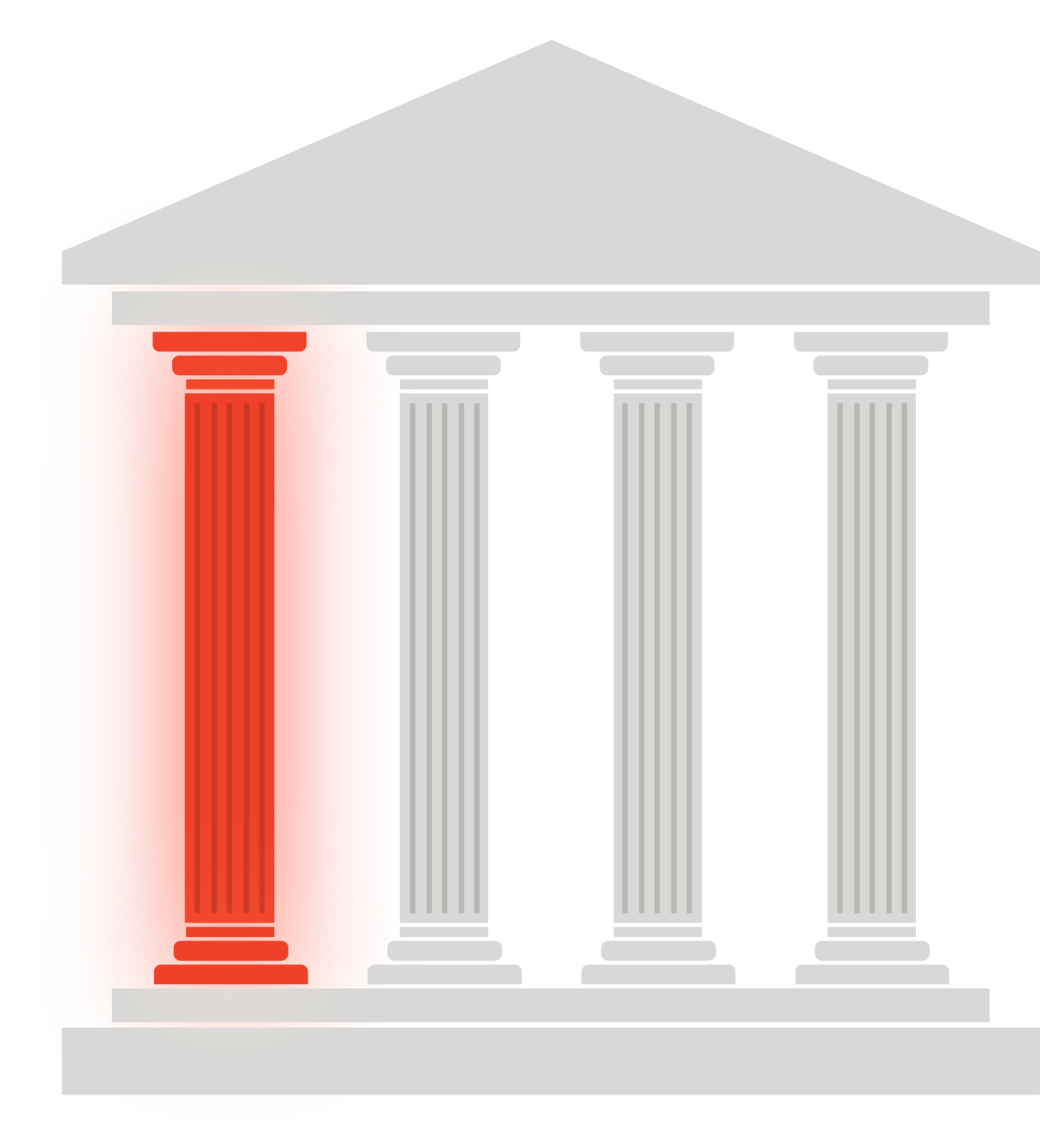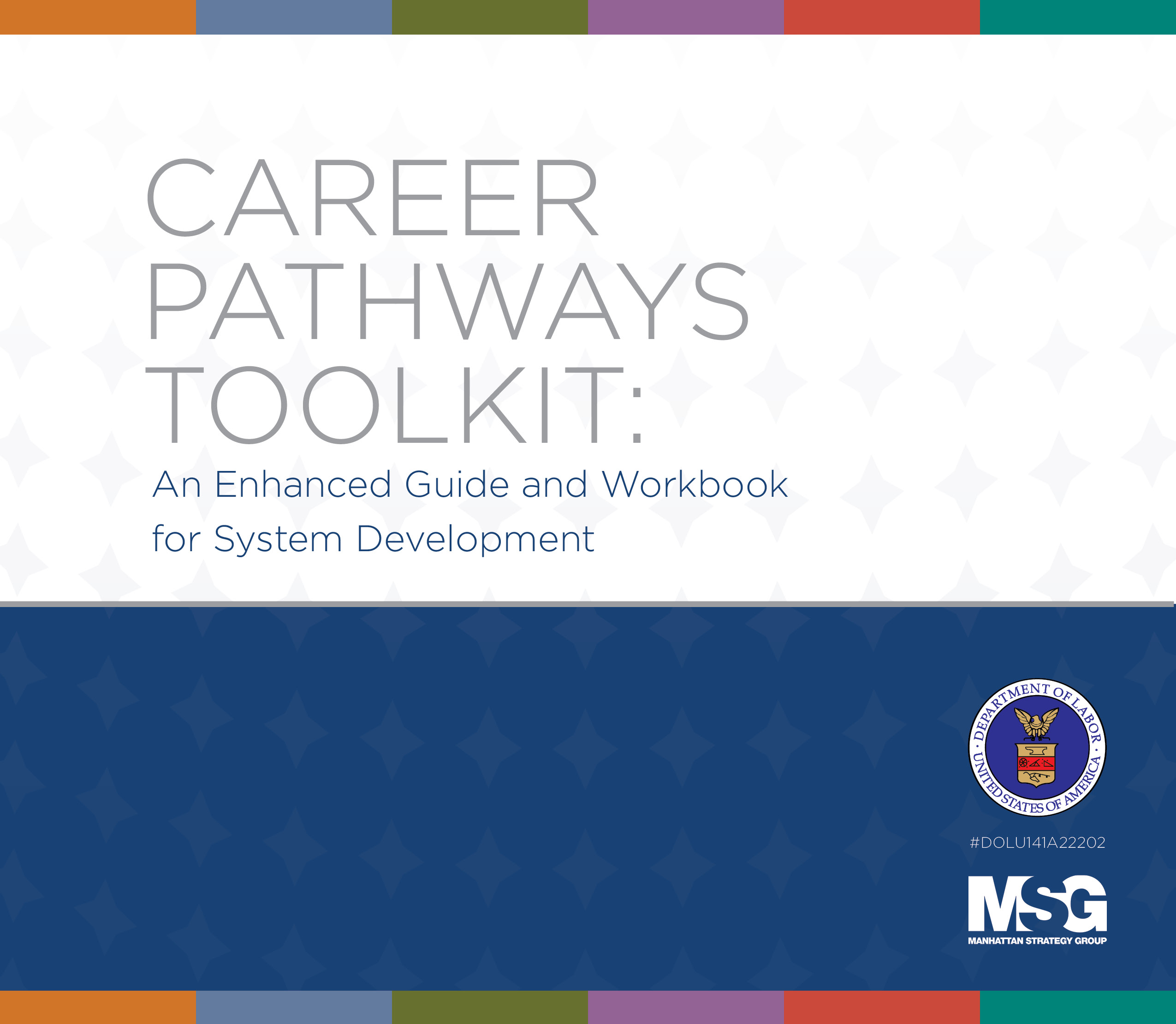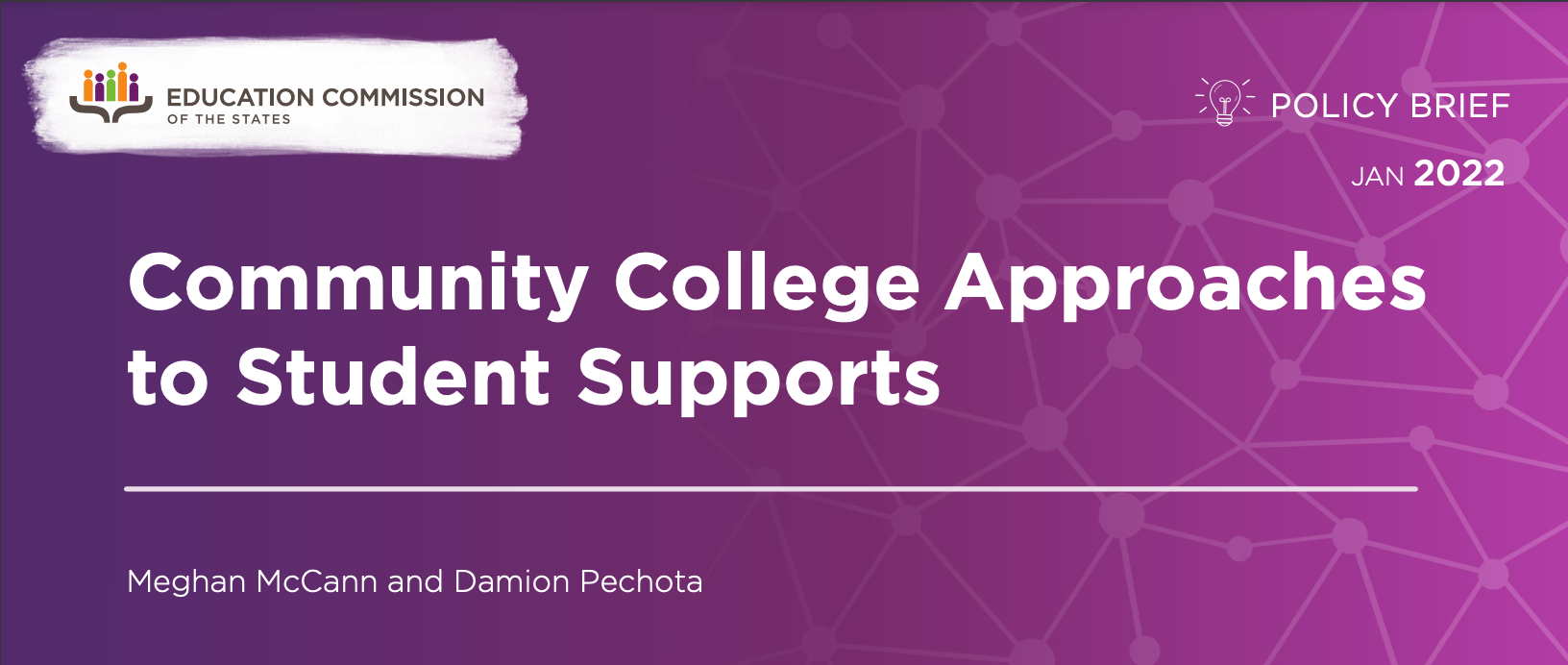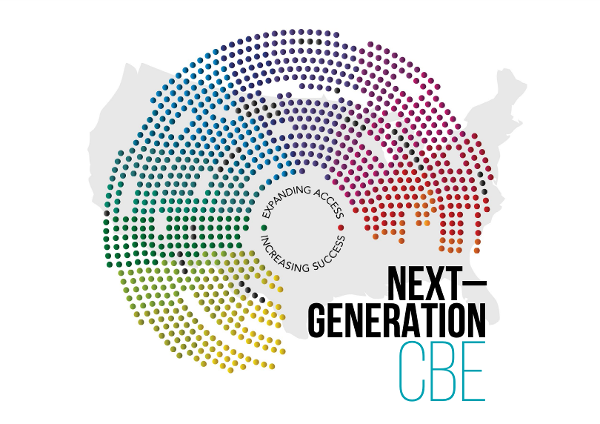Guided Career Pathways
Credentials That Lead to Careers: Building Pathways to Equitable Economic Advancement
Get a copy of the framework sent to your inbox.
Why Guided Career Pathways?
Dramatic disruptions in our labor market and economy require a responsive and dynamic model for postsecondary education. Today’s rapidly changing economy has exacerbated disparities: Black, Latinx, and Indigenous workers, as well as those in low-wage jobs, are experiencing greater barriers to gaining postsecondary credentials than ever before. Many adult learners are seeking faster ways to acquire skills and advance their careers, while employers demand new avenues to develop the skills of their workforce.
The two-year, semester-based model is not suited for this profound economic change. We need a new model, one that reflects the current need for rapid reskilling and a world of work being transformed by technology, that supports adult students balancing family and work obligations, that acknowledges and grants credit for the skills gained through work, and that focuses on racial and socioeconomic equity.
Our Goals
Economic Mobility
Aligning with needs of the labor market to ensure all those who attain postsecondary credentials achieve economic self-sufficiency and can advance in their careers.
Equity
Designing postsecondary systems that meet the needs of all learners, especially Black, Latinx, and Indigenous learners, and members of low-income populations that are currently disproportionately underrepresented in postsecondary education and not adequately served or supported by existing systems.


Three core elements center the Guided Career Pathways vision:
Labor-market-informed pathways
that reflect regional and local economic needs and offer accelerated paths into employment and opportunities to advance.
Expanded outreach, on-ramps, support strategies, and flexible learning models
to better serve adult students and ensure equitable outcomes for learners and workers across racial and socioeconomic lines.
Integrated work and experiential learning strategies
to improve students’ workforce outcomes, build opportunities to earn income, and receive credit for what’s learned on the job.
Integrating Career Pathways
-
Across the Pillars of Guided Pathways
Guided Career Pathways builds on the Guided Pathways framework, which established a strong model for institutional redesign across four goals, or “pillars:” Clarify paths to student end goals, help students choose and enter a pathway, help students stay on that path, and ensure students are learning. These pillars set standards for colleges to structure programs and curricula to support the student experience.
It adds the reforms inherent in Career Pathways, a model embraced by educators focused on career outcomes for students, particularly adult learners and young people who are not in school or working (also known as “opportunity youth”), who have faced barriers to participation in traditional education systems. Career Pathways uplifts labor market-informed approaches, and centers around codesigning with industry groups, employers, community organizations, and the workforce system.
Career Pathways is intentionally designed for learners of varying ages, educational backgrounds, socio-emotional needs, and levels of work experience. It includes robust support services and flexible program models to accelerate credential attainment.
Many colleges across the country, including colleges within the Student Success Center Network, have continued to evolve the work of Guided Pathways by integrating a greater focus of career and employment training. The Guided Career Pathways framework organizes these strategies to help institutions incorporate these reforms.
The Framework Strategies
The strategies within each pillar build on the original four pillars of Guided Pathways, and are drawn from JFF’s extensive work with postsecondary stakeholders implementing Guided Pathways and Career Pathways:
Pillar 1
Create clear curricular pathways to employment and offer opportunities for ongoing skill development to support career mobility.

In Pillar 1 of Guided Career Pathways, we urge close alignment with regional labor market needs, so that all pathways lead to employment and career advancement. Colleges must analyze wage outcomes across the pathways, and disparities by race and gender, so the pathways ensure economic mobility.
The Guided Career Pathways framework urges colleges to design for seamless movement along these pathways, with well-designed on-ramps from one learning experience to another.
Pillar 1 Example
Many states support efforts to help students prepare for quality jobs by assessing the labor market’s in-demand skills and developing pathways, including short-term credential courses in longer-term associate's degree programs, and programs that matriculate to longer-term credentials to allow for continued advancement. Michigan’s “Future for Frontliners,” Virginia’s “FastForward” program, and Florida’s “GetThere” program are a few examples.
Pillar 1 Strategies
Educators need to:
- Develop pathways by regional labor market data created with industry partners that lead directly to quality jobs with opportunities to advance.
- Redesign entry points and enrollment to improve access and equitable outcomes for underrepresented populations, such as Black and Latinx learners, working adults, people from low-income backgrounds, and opportunity youth.
- Build on-ramps from adult basic education, K-12, workplace, community-based organizations (CBOs), and noncredit workforce programs where students have earned credentials.
- Engage employers in the design pathways with industry-recognized short-term credentials that can be applied to longer-term credentials, so learners can obtain employment early in their journey and advance.
- Integrate work-based learning into all pathways, so students can earn as they learn and improve employment prospects with valuable workplace experience.
- Build a robust and transparent system of credit for prior learning (CPL) so that learners’ pathways account for what they know and credentials earned before college entry.
Additional Resources

Career Pathways Toolkit: An Enhanced Guide and Workbook for System Development
This Department of Labor’s Employment and Training Administration (DOLETA) toolkit highlights six key elements of career pathways and actionable steps that state offices, local education and training partners, and workforce development boards can take to align with the Workforce Innovation and Opportunity Act (WIOA).
Realizing the Potential for Rapid Reskilling
This JFF resource provides policy considerations for state and federal policymakers and provides examples and guidance useful to practitioners seeking to build high-quality short-term credentialing programs.

When is a Job Just a Job – and When Can it Launch a Career?
This report, co-authored by JFF and Burning Glass Technologies, details an “Opportunity Framework” and a way to identify pathways leading to “lifetime” and “springboard” jobs that offer family-supporting wages, versus “static” jobs with fewer opportunities for advancement, drawing from an unprecedented analysis of nearly 4 million resumes of jobseekers.

Employer Engagement Toolkit: From Placement to Partners
The Employer Engagement Toolkit provides a step-by-step guide for organizations seeking to deepen their relationships and value to employer partners to bring collaborations beyond placement partners to dedicated co-designers.
Pillar 2
Help students choose and enter their pathways, build on prior experience, explore career options, and connect with work.

In Guided Career Pathways, Pillar 2 focuses on redesigning the student onboarding experience to help students build on existing skills and knowledge. Many of today’s community college students come with a robust history of work experience, industry-recognized credentials, and college credits without degrees. College advising and career development must be designed for equitable access and outcomes and recognize skills students have already earned. Since higher rates of Black and Latinx students, and students with low incomes, choose short-term credentials, equity-focused colleges should design pathways that begin with a short-term credential, but have long-term options leading to career advancement beyond an entry-level job.
Pillar 2 Example
Many colleges are redesigning the onboarding experience to help students explore and enter a career path. Some are offering credit for prior learning to ensure adult learners get course credit for their skills and knowledge. Several states, including California, Wisconsin, and Colorado, have developed statewide systems so colleges can more easily assess all incoming students for skills and credentials already earned.
Pillar 2 Strategies
Educators need to:
- Provide robust career navigation and career advising services throughout the learner’s journey that support economic stability through lifelong learning and work.
- Redesign onboarding and orientation to help learners select a program pathway based on their prior skills, knowledge, and interests.
- Integrate a transparent, easily navigable process of credit for prior learning at onboarding for all new students—a critical equity tool for working adults.
- Build outreach and onboarding processes with CBOs and the workforce system to provide underrepresented learners career guidance and support during enrollment.
Additional Resources

MyBestBets Career Navigation Tool and Mobile Application
This resource explains JFF’s MyBestBets, a web platform designed to help guide low-income young adults make education and training choices that will lead to high-demand and high-growth careers. It includes tools and resources for career coaches and career services staff.

The Four Stages of Building an Effective and Inclusive CPL Program
This Council for Adult and Experiential Learning (CAEL) resource discusses four ways to gain leadership support for Credit for Prior Learning (CPL) strategies, in order to help CPL champions design, implement, and improve CPL programs while meeting student needs within specific institutional contexts.

State Policy Roadmap for an Equitable Economic Recovery: Universal Career Navigation Services
This JFF tool provides examples and actionable steps that state leaders can take to develop universal career navigation services that are tech-enabled, place-based, and widely accessible to workers and learners.
Taking the Long View: Designing Pathways for Economic Mobility
This article describes the importance of partnerships between educators and community-based organizations, to create on-ramps for people with low incomes and other marginalized populations to career pathways leading to economic advancement.
Pillar 3
Help students stay on their paths to complete their employment and transfer goals, and design programs with the flexibility to allow learners to reenter at any point.

Pillar 3 under Guided Career Pathways recognizes the varied journeys of individual learners, and expands the supports and flexibility that help students persist. Many students juggle family and work responsibilities as they pursue education, and often interrupt their studies. Retention and reengagement strategies, program models that accommodate the needs of all learners, and tailoring supports to address individual needs each foster more equitable outcomes. We can build such programs by collaborating with transfer partners, workforce development boards, and CBOs to provide the holistic supports and case management services many students need.
Pillar 3 Example
New Jersey community colleges partner with CBOs to provide housing and food assistance. These efforts, supported by the New Jersey Center for Student Success, help students experiencing financial insecurity stay on a path to completion. Five states in JFF’s Student Success Center Network have partnered with the Hope Center to address students’ basic-needs insecurity on their college campuses.
Pillar 3 Strategies
Educators need to:
- Build holistic academic and personal resources for students through partnerships with community-based organizations and workforce development boards. Engage learners to design effective, culturally competent programs.
- Recognize that costs go beyond tuition. Ensure students can access all financial assistance, including public benefits, tuition assistance, emergency grants, and housing or food assistance. Limit program costs by relying on open-source curricula and resources.
- Use data-sharing and shared case management systems with community-based organizations, workforce development system partners, and transfer institutions to help students persist and to track outcomes across these organizations for continuous improvement.
- Support students who must work and help them access opportunities to earn while learning, including apprenticeship and work-based learning programs.
- Offer varied delivery models, including online, self-paced, competency-based, and modularized formats, which allow students to adjust the pace of learning to accommodate life circumstances.
- Provide students with the right academic support to succeed in alternative models.
Additional Resources

Accelerating Pathways to Careers for Adult Learners
Co-authored by JFF and the U.S. Department of Labor, this brief explores three evidence-based, career pathway strategies funded by the Trade Adjustment Assistance Community College and Career Training (TAACCCT) grant program that serve adult learners: on-ramps to college and support at entry, program design innovations, and student support and career pathway services.
Designing with Equity in Mind: An Action Toolkit for Competency-Based Education
This action-based toolkit, coauthored by JFF and the Competency-Based Education Network, is designed for cross-functional college teams to use to develop equity-focused CBE strategies that identify problems, set goals, and create action plans that center learners and remove systemic barriers.

Community College Approaches to Student Supports
This resource from the Education Commission of the States is designed for community college leaders and outlines the wraparound and basic-need support that can be provided to students pursuing educational credentials to foster enrollment, persistence, and completion.

Next-Generation Competency-Based Education: Solving the Four Big Problems Facing CBE for Underprepared Learners
This JFF resource is designed for educators and policymakers and examines four primary challenges related to Competency-Based Education (CBE), proposing solutions via CBE approaches to corequisite developmental education.
Pillar 4
Ensure that learning happens with intentional learning outcomes and assessment in both the classroom and work-based settings.

In addition to ensuring that teaching practices are culturally appropriate and inclusive, Pillar 4 of the Guided Career Pathways framework calls for programs to add robust work-based learning opportunities. This strategy introduces students to occupations and industries, gives them practical experience to master skills they learn in class, and builds an understanding of workplace processes. In addition, work-based learning helps open avenues to advancement for students of color who are overrepresented in entry-level roles. Work-based learning models should measure and grant credit for knowledge gained in the workplace. Competency-based education models should be incorporated into all programs in order to measure knowledge gained rather than just time spent in the classroom.
Pillar 4 Example
Lorain County Community College in Ohio’s FastTrack program integrates on-the-job training and classroom instruction to give students practical experience preparing for family-supporting employment in high-demand fields. These short-term credential programs lead to longer-term certificate and degree programs.
Pillar 4 Strategies
Educators need to:
- Work with employer partners to align coursework with on-the-job skill-building.
- Help learners synthesize and articulate their knowledge and skills through an e-portfolio or reflection exercises.
- Help faculty understand how workplace skills and industry-recognized credentials align to the curriculum for continuous assessment and improved learning.
- Scale competency-based programs, so all learners can pursue credentials at their own pace and reduce time spent on material they already know.
Additional Resources

About Work-Based Learning
This resource provides examples of work-based learning programs, outlines types of work-based learning models, and links to JFF’s Center for Work-Based Learning and Apprenticeship—an extensive set of resources for educators and employers.

Promising Trends and Challenges in Work-Based Learning
This JFF market scan of K-12 and postsecondary organizations, programs, and tools reviews trends in career exploration and work-based learning, including career experience, career exposure, career engagement, employer-driven examples, curriculum resources, and distinguishing features of successful programs.
The Role of Equity, Policy, and Tech
Equity
Implementing these strategies alone will not close equity gaps. Instead, we must center equity practices within the purview of pathways work and maintain intentionality in the design of each strategy, using data to examine closely who lacks access to programs and pathways and asking why those learners or workers are being left behind or excluded. We must codesign outreach and enrollment approaches with community partners and create supports that work across our learning and work ecosystems, integrating holistic supports tailored to the needs of specific populations.
Policy
To make progress across all four pillars, we must also advance federal and state education and workforce policies to support inclusive and effective programmatic and funding reforms. We must adopt policies promoting short-term training and more transparent access to wage and employment earnings data.

Integrated Technology and Data Systems
Stronger data systems are essential infrastructure to design equitable pathways. As pathways designers, we must prioritize:
- Tracking and recording learners’ workforce outcomes (wages and career mobility).
- Building data systems to track student progress across steps on the pathways and into employment, disaggregated by race.
- Updating and revising pathways based on completion and employment data by different demographic groups and based on changing opportunities in the labor market.
To continue implementing and utilizing early alert systems, colleges should also prioritize technology in teaching and learning, electronic transcription, and career navigation technology.
Additional Resources

End Occupational Segregation: A Purpose-Built Call to Action
This resource outlines specific strategies for educators to reduce equity gaps in access and completion, and describes two key approaches to promoting economic mobility for Black learners: by reimaging education and training systems to promote credentials with labor market value, and by eliminating discrimination in the labor market and workplace.

2020 Career Navigation Technology—A Technology Market Poised for Innovation and Impact
This JFFLabs market scan is designed for employers, investors, philanthropists, and entrepreneurs seeking to understand the career navigation platforms, innovations, and strategies employed at nonprofits and other organizations.

How Three States Use Data To Improve Student Job Outcomes and Meet Employer Needs
This brief, co-authored by JFF and the U.S. Department of Labor, outlines how Kansas, Massachusetts, and Missouri used data integration to address education and workforce needs.
Realizing the Potential for Rapid Reskilling
This JFF resource provides policy considerations for state and federal policymakers and provides examples and guidance useful to practitioners seeking to build high-quality short-term credentialing programs.
Drawing on Two Powerful Pathways Reforms
Guided Pathways
More than 400 colleges have implemented the Guided Pathways model, and research suggests it is a powerful framework for redesigning the student experience and provides a measurable boost to student success.
Since 2011, JFF has been a leader in Guided Pathways, and in 2015, JFF joined the Pathways Collaborative in the most prominent effort to implement Guided Pathways across the country. JFF helped develop the four-pillar Guided Pathways model and supported a national effort to design, scale, and implement Guided Pathways. JFF also built the 17-state Student Success Center Network—an initiative that has advanced Guided Pathways at more than 50 percent of community colleges nationwide.
Career Pathways
The Career Pathways model has been embraced by educators focused on career outcomes for students, particularly adult learners and opportunity youth, who have faced barriers to participation in traditional education systems. JFF helped develop the first Career Pathways toolkit published by the U.S. Department of Labor in 2011. Since then, JFF has worked on implementing Career Pathways nationally, including supporting the 256 colleges and consortia grantees of the U.S. Department of Labor’s Trade Adjustment Assistance Community College and Career Training (TAACCCT) initiative, helping design education and training programs that lead to high-value credentials.
Join Us
Expand and Strengthen Guided Career Pathways
JFF invites postsecondary leaders to reexamine Guided Pathways and Career Pathways, using these complementary reforms as a catalyst to boost learner and worker attainment and workforce alignment to revitalize local economies and foster an equitable economic recovery. We are excited to work with partners to scale these promising strategies under this new vision, broaden our definition of success, and identify opportunities for policy change.
In addition to calling for changes in practice, we must join postsecondary leaders in advocating for education and workforce training policies and funding models that facilitate adopting and scaling the strategies we propose. JFF is excited to begin working with partners in the field to bring these promising strategies to scale, broaden our definition of success, and identify opportunities to work together.
To learn more or contribute to these strategies,

